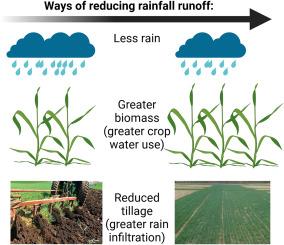The potential to reduce runoff generation through improving cropping and tillage practices in a sub-humid continental climate
引用次数: 0
Abstract
Agricultural sustainability is threatened by both water deficit and water excess, especially at the presence of extreme meteorological events resulting from climate change. However, there has been lack of demonstrations on management options with long-term values for agricultural adaptation to runoff. Using 20 years of monitoring data (1993–2012) for two experimental fields in the Canadian Prairies as a case study, we quantified the effects of rainfall characteristics, crop type and biomass, and tillage on growing-season runoff generation using regression analyses and thereafter scenario comparisons. With growing-season gross rainfall ranging between 183 and 456 mm, runoff responses varied between 0 and 59 mm. Over the 20-year study period, 70%–74 % of the growing-season runoff was generated by rainfall events >100 mm. Compared to high-intensity tillage, long-term conservation tillage reduced both overall runoff and runoff in large events likely by improving water infiltration. Under both tillage methods, growing-season runoff significantly increased with increasing rainfall but decreased with increasing biomass (R2 range: 0.40–0.58; p range: 0.0007–0.02). At the event level, the rainfall-runoff relationship followed a piecewise regression model (Cd = 0.82; p < 0.0001; “breakpoint” rainfall event = 105 mm), in which runoff increased slowly before reaching the “breakpoint” but rose sharply afterwards. Due to a greater biomass, canola resulted in less runoff than wheat. Scenario analyses showed that increasing crop biomass by 50 % under the current average rainfall conditions could reduce runoff by 81–86 % in wheat and 100 % in canola. The reduction may be attributed to the combined effects of crop on interception, evapotranspiration, and infiltration. In conclusion, although in a sub-humid continental climate like the Canadian Prairies there are generally low amounts of rainfall runoff, this study demonstrates significant runoff in some years, especially following large rainfall events. Runoff generation can be significantly reduced through improving cropping and tillage practices, and such effects on regional water retention should be further assessed by considering the past and future changes in climate and management.

在亚湿润大陆性气候条件下通过改进种植和耕作方法减少径流产生的潜力
农业的可持续发展受到水资源短缺和过剩的威胁,尤其是在气候变化导致极端气象事件的情况下。然而,在农业适应径流方面,一直缺乏具有长期价值的管理方案示范。以加拿大草原两块试验田 20 年(1993-2012 年)的监测数据为例,我们通过回归分析和此后的情景比较,量化了降雨特征、作物类型和生物量以及耕作对生长季径流产生的影响。生长季总降雨量介于 183 毫米和 456 毫米之间,径流响应介于 0 毫米和 59 毫米之间。在 20 年的研究期间,70%-74% 的生长季径流是由 100 毫米的降雨量产生的。与高强度耕作相比,长期保护性耕作减少了总体径流和大降雨量时的径流,这可能是通过提高水的渗透率实现的。在两种耕作方法下,生长季径流随着降雨量的增加而显著增加,但随着生物量的增加而减少(R2范围:0.40-0.58;P范围:0.0007-0.02)。在事件水平上,降雨与径流的关系遵循片断回归模型(Cd = 0.82;p < 0.0001;"断点 "降雨事件 = 105 毫米),其中径流在达到 "断点 "之前缓慢增加,但在达到 "断点 "之后急剧增加。由于生物量较大,油菜籽的径流量比小麦少。情景分析表明,在当前平均降雨量条件下,作物生物量增加 50%,可使小麦径流量减少 81-86%,油菜籽径流量减少 100%。径流减少的原因可能是作物对截流、蒸散和渗透的综合影响。总之,尽管在加拿大大草原这样的亚湿润大陆性气候中,降雨径流量通常较低,但这项研究表明,在某些年份,尤其是在降雨量较大的年份,径流量很大。通过改进种植和耕作方法,可大大减少径流的产生,而且应考虑到气候和管理方面过去和未来的变化,进一步评估这种情况对区域水源涵养的影响。
本文章由计算机程序翻译,如有差异,请以英文原文为准。
求助全文
约1分钟内获得全文
求助全文

 求助内容:
求助内容: 应助结果提醒方式:
应助结果提醒方式:


